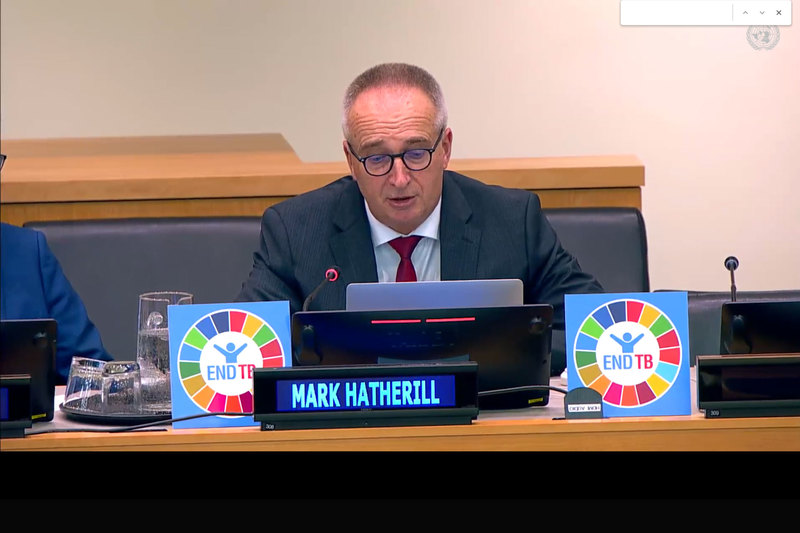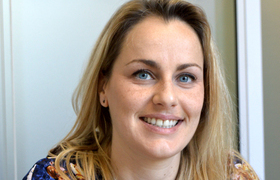UCT prof calls for increased investment in TB vaccine research
03 October 2023 | Story Kelvin Vollenhoven. Photo United Nations. Read time 6 min.
During a panel discussion of the United Nations High-level Meeting on Tuberculosis (TB) held in New York recently, Professor Mark Hatherill, the director at the South African Tuberculosis Vaccine Initiative (SATVI) based at the University of Cape Town (UCT), called for a quantum jump in TB vaccine research and development (R&D) funding, to deliver the transformative tools needed to end the TB pandemic.
In his presentation, Professor Hatherill reflected on the unprecedented advances made in new diagnostics and treatments to reduce the severity of TB disease, and risk of death, for TB patients. Although these advances are necessary, he said, they are not sufficient to end TB. A vaccine that prevents people from getting TB and infecting others is key to stopping the epidemic.
“A vaccine that prevents people from getting TB and infecting others is key to stopping the epidemic.”
For the first time, the most advanced TB vaccine candidate, the M72AS01E, brings us close to achieving a new, safe and effective TB vaccine. In a phase 2b trial, this vaccine has shown 50% protection in adults exposed to TB, and will soon enter a large confirmatory trial, which is expected to deliver results within five years.
If vaccine protection is confirmed, the impact will be transformative for TB control efforts. Over a 25-year period, such an effective vaccine could prevent up to 76 million TB cases, 8.5 million TB deaths, and result in a US$3.8 billion saving in treatment costs.
Strategy needed
Finance for a comprehensive R&D strategy for all seven late-stage TB vaccines is needed to reach their full potential. There is also a critical shortage of early-stage vaccines in the TB vaccine pipeline and therefore urgent investment is needed to move the most promising, including mRNA vaccines, through human trials.
“To ensure uptake of vaccines in communities, we need to partner with affected communities in high TB-burden countries to help deliver information about vaccines in ways that resonate with those communities, and to help scientists ask the right questions,” said Hatherill. “Which new TB vaccines will be safe and effective in people living with HIV? And in the elderly, infants, and people not yet exposed to TB? We also need to address the fundamental question of how to recognise the protective immune response to vaccination.”
“The fact that the TB epidemic persists in 2023 is an indictment of our lack of urgency to tackle [this] pathogen.”
This work will require a major leap in annual investment in TB vaccine research, which is currently only 12% of current TB R&D funding and less than a fraction of 1% of the US$100 billion which was committed to COVID-19 vaccine development. The bold response to the COVID-19 pandemic saw 40 efficacy trials, with more than 400 000 volunteers, produce a dozen approved COVID-19 vaccines in only three years.
“By contrast, decades of underfunding for TB vaccines blunted the scope of our ambition. A cautious approach of ad hoc funding of individual vaccine trials did not and will not accelerate TB vaccine development. We need a programme of investment in the entire TB vaccine pipeline that both tolerates the inherent risk in R&D and reduces commercial uncertainty, to do the trials that are necessary, and not those trials we think we can afford,” Hatherill said.
Collective response
Investment in TB vaccines cannot be left to a handful of funders in low TB-burden countries, he stressed. To ensure an equitable say in the TB vaccine research agenda, and to ensure that the voices of affected communities are heard, stakeholders in high TB-burden countries must contribute their fair share of funding for development. Delivery of a new TB vaccine will require a collective response from governments, industry, scientists and civil society, to conduct more trials of more vaccines more quickly, and to prepare health systems for their implementation.
In conclusion, he posited that a new, safe and effective vaccine to break the cycle of TB transmission among adults could be delivered within the next five years. Such a vaccine could save millions of lives, avert the burden of disease for tens of millions of patients and their families, and save billions of dollars in health system costs by 2050.
“TB is no less of an emergency than it was 30 years ago.”
Supply of the best TB vaccines to the communities that need them will require an immediate quantum jump in investment – not only for accelerated vaccine testing, but also for implementation studies and to ensure sustainable, diversified manufacture.
“The fact that the TB epidemic persists in 2023 is an indictment of our lack of urgency to tackle a pathogen that has affected humans for thousands of years. TB is no less of an emergency than it was 30 years ago.
“Let us imagine that Mycobacterium tuberculosis was discovered today, an infectious airborne pathogen that in the coming year would cause 10.6 million people to fall sick with TB, and 1.6 million TB deaths. We should not need to imagine the bold response to this global health emergency and the rapid mobilisation of funding to make new vaccines against this devastating disease.
“So let us stop imagining and find the political will to deliver these new vaccines to end TB.”
 This work is licensed under a Creative Commons Attribution-NoDerivatives 4.0 International License.
This work is licensed under a Creative Commons Attribution-NoDerivatives 4.0 International License.
Please view the republishing articles page for more information.










